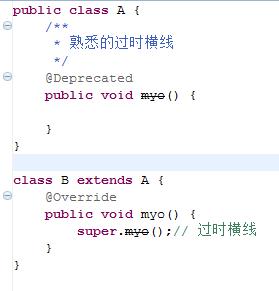简介
- 这不是注释
- 从JDK5才开始支持Annotation注解机制
- 访问处理Annotation的工具统称APT
- 一种是给程序用的注解,基本注解
- 一种是给注解用的注解
基本Annotation
- @Override 标记重写父类方法
- @Deprecated 标记已过时
- @SuppressWarnings 抑制警告信息
- @SafeVarags 抑制“堆污染”警告信息
- @FunctionalInterface 标记为函数式接口
@Override
强制指定这个方法重写父类方法,如果这个方法不是父类方法,会报编译错误。
这样做的目的是为了避免程序员重写时犯低级错误。
public class A {
public void myo() {
}
}
class B extends A {
@Override
public void myo() {
}
/**
* 这里会报编译错误,那是个零
*/
@Override
public void my0() {
}
}@Deprecated
标示这个方法、类已经过时了,当其他程序使用这个过时的方法、类就会给出警告。
@SuppressWarnings(value={String})
抑制编译警告信息。
如果抑制了这个类,就抑制了这个类内的所有方法,抑制了方法,就抑制了这个方法内的每行代码
抑制警告关键字
| 关键字 | 用途 |
|---|---|
| all | 抑制所有警告 |
| boxing | to suppress warnings relative to boxing/unboxing operations |
| cast | to suppress warnings relative to cast operations |
| dep-ann | to suppress warnings relative to deprecated annotation |
| deprecation | to suppress warnings relative to deprecation |
| fallthrough | to suppress warnings relative to missing breaks in switch statements |
| finally | to suppress warnings relative to finally block that don’t return |
| hiding | to suppress warnings relative to locals that hide variable |
| incomplete-switch | to suppress warnings relative to missing entries in a switch statement (enum case) |
| nls | to suppress warnings relative to non-nls string literals |
| null | to suppress warnings relative to null analysis |
| rawtypes | to suppress warnings relative to un-specific types when using generics on class params |
| restriction | to suppress warnings relative to usage of discouraged or forbidden references |
| serial | to suppress warnings relative to missing serialVersionUID field for a serializable class |
| static-access | to suppress warnings relative to incorrect static access |
| synthetic-access | to suppress warnings relative to unoptimized access from inner classes |
| unchecked | to suppress warnings relative to unchecked operations |
| unqualified-field-access | to suppress warnings relative to field access unqualified |
| unused | 抑制未使用警告 |
@SafeVarags
这个注解是Java7以后才支持的
什么是堆污染?
“堆污染”即是将一个不带泛型的变量赋值给一个带泛型的变量,将导致泛型变量污染,如果不加上面注解,编译器将给于提示,避免运行时异常。
代码
import java.util.ArrayList;
public class A {
public static void main(String[] args) {
ArrayList arr = new ArrayList<Integer>();
arr.add(20);
ArrayList<String> arrS = arr;
System.out.println(arrS.get(0));
}
}消除这类警告办法
- @SafeVarags
- @SuppressWarnings(“unchecked”)
- 编译时使用-Xlint:varargs选项(博主没实践过,听别人说的,有兴趣的可以试试)
@FunctionalInterface
- Java8以后才支持的
- 只支持接口修饰
- 定义这个接口是函数式接口
- 函数式接口:只有一个抽象方法,可以后多个默认方法或多个static方法的接口
- 作用:如果这个接口不是函数式接口,就会报编译错误,帮助程序员纠错
- 出现目的:为了Lambda表达式准备的
JDK的元Annotation
用于修饰注解的注解
- @Retention 保留时间
- @Target 作用对象
- @Documented
- @Inherited
@Retention(value)
用于指定被修饰的Annotation可以保留多长时间
| value值 | 含义 |
|---|---|
| RetentionPolicy.CLASS | 编译器把Annotation记录在class文件中。当Java程序运行时,JVM不能获取Annotation信息。这是默认值 |
| RetentionPolicy.RUNTIME | 编译器把Annotation记录在class文件中。当Java程序运行时,JVM获取Annotation信息,也能通过反射获取Annotation信息。这是保留到运行时 |
| RetentionPolicy.SOURCE | Annotation保留到源代码中,编译器直接丢弃 |
@Target(value)
用于指定被修饰的Annotation能用于程序的那些对象
| value值 | 含义 |
|---|---|
| ElementType.ANNOTATION_TYPE | 该Annotation能修饰Annotation |
| ElementType.CONSTRUCTOR | 该Annotation能修饰构造器 |
| ElementType.FIELD | 该Annotation能修饰成员变量 |
| ElementType.LOCAL_VARIABLE | 该Annotation能修饰局部变量 |
| ElementType.METHOD | 该Annotation能修饰方法定义 |
| ElementType.PACKAGE | 该Annotation能修饰包定义 |
| ElementType.PARAMETER | 该Annotation能修饰参数 |
| ElementType.TYPE | 该Annotation能修饰类、接口、注解类接口、枚举 |
| ElementType.PARAMETER | Java8 |
| ElementType.USE | Java8 |
@Documented
用于指定被修饰的Annotation能被javadoc工具提取成文档。
就是提取API的时候,Documented也能提取出来。
@Inherited
用于指定被修饰的Annotation具有继承。
就是B继承A,如果A添加Annotation修饰,那么B也有相同的Annotation修饰,前提是这个Annotation具有继承性。
Java8新增注解
@Repeatable
重复注解























 1197
1197











 被折叠的 条评论
为什么被折叠?
被折叠的 条评论
为什么被折叠?








